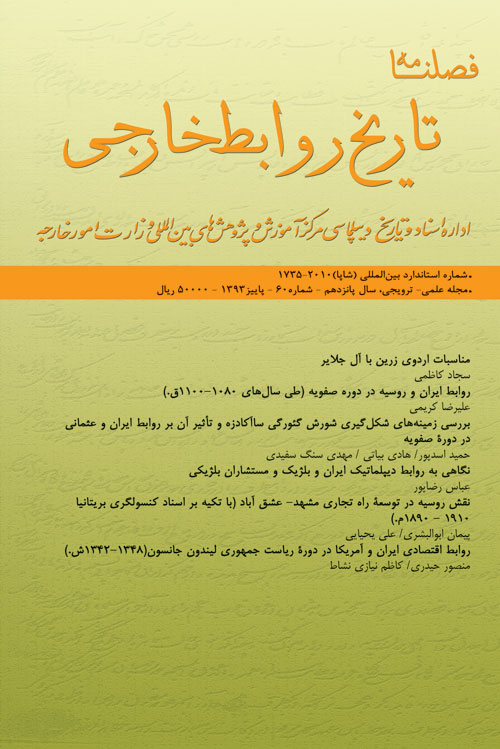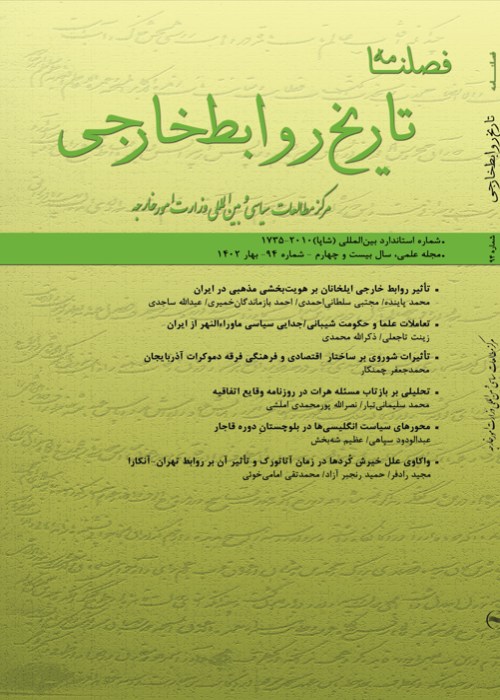فهرست مطالب

فصلنامه تاریخ روابط خارجی
پیاپی 60 (پاییز 1393)
- تاریخ انتشار: 1393/08/14
- تعداد عناوین: 6
-
-
Page 1As the territories of the Mongol Empire was divided among the descendants of Genghis Khan, the tribal relationships between the members of a house determined the relations between different regins. In this regard, the relations between the rulers of Cuman-Kipchak confederation (The golden horde) with the Ilkhanates in Iran, and consequently with the Jalairid Sultanate as the political heirs to the Ilkhanates, is greatly important. Although the Jalairids were not in thrall to the Imperial House, as a mongol tribe they played an important role in Genghis conquests and in the establishment of the Ilkanate rule. Furthermore, they replaced the Ilkhanates in the relations with the Khans of Cumancia. The current research has employed a historical method and has enjoyed first-hand sources in exploring the relations between the Golden Horde and the Jalairid rulers. Our assumption is that the approach adopted by Cumancia Khans in engaging with the Jalairids, is the continuation of the belligerent policies formerly employed in dealing with the Ilkhanates. The findings of this research suggest that Azerbaijan was at the crossroad of these relations, as a result of which Tabriz became hotbed of tensions of conflicts on various occasions. Although the rise of Teimur as a common enemy could be a turning point in the Jalairids relations with the Golden Horde, however, their plans for unity fell through and triggered the decline and fall of the two.Keywords: Mongols, Ilkhanates, Jalairids, Relations
-
Page 25There is a host of various signs that distinguish the two decades of 1080- 1100 during the Safavid period. Among the various signs mentioned, one is the adoption of a logical and prudent foreign policy on the part of the theninterim government. Expanding political and economic relations with Russia, as part of a greater plan for détente with Northern and Western neighbors, was one of the peculiarities of this period among other things. This approach facilitated the balanced economic relations with other powers and prompted economic prosperity in Iran. The Iranian state adopted a rational approach to foreign relations in this period and resisted the Russian push for invading the Ottomans; since it considered a strong Russia more menacing than the Ottomans. On the other hand, Irans chancellor (Wazir) sought to clearly explain the reasons for rejecting Russians suggestion for amilitary alliance with Iran against the Ottomans in an attempt to appease the northern neighbor. Irans relative agreement with Russias trade strategy secured the boundaries to the north as well as attaining numerous political and economic gains. This article is of a fundamental and theoretical nature which draws on library sources to gather and analyze data, and predicates upon content analysis and descriptive-analytical methodology.Keywords: Iran, Russia, Foreign Relations, Safavid
-
Page 37Towards the final years of the reign of Shah Abbas the Great in the year 1033 (AH) a rebellion was started in the state of Georgia by Mouravi, and lasted until Shah Safi era in 1044 (AH). This rebellion was an episode of elite struggle for seizing political power. Through inciting the great Georgian lords, Mouravi managed to unite them to rise in rebellion against Shah Abbas I. The raid on the Qizilbash army in Kakht and the killing of the Safavid famous generals, Qarchqai Khan and Yusif Khan, marked the beginning of this rebellious episode, which soon evolved to spill over other areas in Georgia and inflicted north-western expanses of Iran with crisis. The ramifications of this rebellion drew a quick response from Shah Abbas I to suppress it, specifically as the Ottomans were exploiting this rebellion and were manipulating the disillusioned Georgian greats against the central state in Iran. Mouravis thirst for power and his personal incentives are of great importance in studying the roots of this rebellion and the exile of Mouravi. Furthermore, the violent response from Shah Abbas I and Shah Safi in dealing with the Georgian and Mouravis sense of revenge against the Qizilbash should not be ignored in analyzing this episode.Keywords: Iran, Ottoman, Giorgi Saakadze, Rebellion
-
Page 59According to many historical sources, the year 1841 marks the beginning of the first diplomatic contacts between Iran and Belgium. The relations between the two countries climaxed as Belgian advisors entered Iran to contribute to the management of the Customs, Post and Irans Finance. Belgiums control over the Customs as a measure to guarantee Irans loans was a major breakthrough in Iranian foreign relations with this European country. The article gives a detailed account, based on the documents of Irans Ministry of Foreign Affairs, of the early stages of relations between Iran and Belgium including the establishment of embassies and the Belgians activities in Iran.Keywords: Iran, Belgium, Diplomatic relations, Belgian Advisors
-
Page 127US-Iran economic relations is an important aspects of the relations between the two countries in the Second Pahlavi era, during which, the economic development planning for Iran was devised and implemented by American advisors. The Export-Import plan between Iran and America (1963-1969), simultaneous with Lyndon B. Johnsons presidency, saw a tangible breakthrough. Since 1340 SH the major strategy adopted by the Shah was to create a major domestic market for foreign industrial products; a strategy which was mainly driven by huge revenues from oil exports. Although the US economic aid to Iran was terminated or ultimately declined, like many other areas of cooperation, in the mid 60s, the ties between the two countries were strong nonetheless. The US had planned to allocate longterm loans of fixed interest rates to Iran after it had cut the economic aid program, in an attempt to hold Iran under its sway and keep the Iranian market open to its products.Keywords: Iran, the US, Economic Relations, Lyndon B. Johnson


